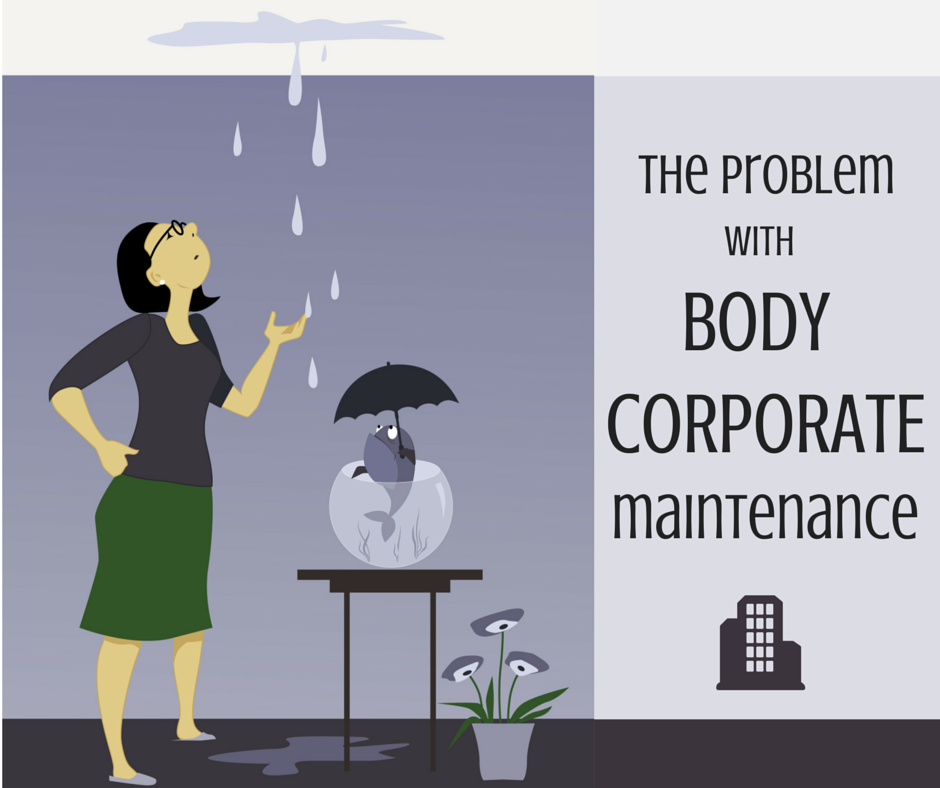One of the most attractive things about living in a body corporate is the ability to have the body corporate maintenance undertaken by someone who isn’t you.
Of course there’s always a trade-off and in this case it’s that you pay quite handsomely for the privilege.
And that’s the fundamental problem with body corporate maintenance; as a lot owner you can find yourself in a position where you’re paying and paying and paying but necessary repairs are not happening.
But before you start grumbling about your Committee there are some things you should consider.
Problems with body corporate maintenance arise because of two simple assumptions that regularly turn out to be untrue:
- that the building was fit for purpose in the first place, and
- that everyone involved knows what they’re doing
The Building Was Fit For Purpose
All buildings start out as ideas that eventually end up as a plan. Usually they’re complex, well thought out ideas but it still remains a challenge for a builder to take those plans and convert them into reality.
It doesn’t always happen successfully.
New building defects are common and rife. Resolving these issues is a long and involved process but in the majority of cases they do eventually get sorted.
Some body corporates though end up with significant design flaws that quite simply don’t work and likely never will.
That can be things like hallways or stairs that go nowhere, decorative or design features that are already obsolete before the building is complete or the ever popular water leaks. Honestly, I’m astounded with how many new buildings are not water tight!
Resolving these issues is not maintenance.
Maintenance is caretaking and a significant number of body corporates are finding themselves in a position where they have to first finish a building to acceptable standard before they can get on with the business of taking care of it.
Design and construction defects are not the result of anything management has done.
Everyone Knows What They’re Doing
One of the things I love about body corporates is here are these amazing buildings which operate within a heavily legislated environment and the decision makers, the Committees, are predominantly laypeople.
They may have some knowledge but it’s unlikely they have a grounding in everything a body corporate might need.
Body corporate Committees are therefore reliant on hired professionals to help them both conduct the business of the body corporate and if necessary resolve issues.
Unfortunately that can mean an already long process (Committees are volunteers who meet irregularly) is further hampered by the necessity to actually find someone who knows what they’re doing before the symptoms can even be assessed and potential solutions considered.
And just finding the professional help a scheme needs can sometimes seem bigger than Ben Hur.
Larger building’s fare better here as they have deeper pockets and more complex (ie profitable) issues attracting more professionals. Smaller schemes sometimes have difficulty dredging up two quotes for comparison let alone actually getting the work done.
Consistent Maintenance is Vital
There’s been a lot of talk recently of South East Queensland rotting away from concrete cancer.
There are a lot of body corporates that have, or previously had, concrete cancer. How that works out will depend on whether or not action is taken to rectify the issues.
Concrete cancer can be dealt with relatively easily, though the repairs can be costly and time consuming.
Failure to take action though, either to repair identified instances or to paint and protect the concrete’s porous surface, and the cancer will spread eventually weakening the structure of the building if it gets bad enough.
Poor body corporate management and apathy amongst lot owners are common, as is the consistent drive to keep levies low often at the expense of undertaking works. It’s common to see issues discussed and shelved as “too expensive” often without addressing again until the problem has reached worrisome proportions.
It all leads to this frustrating situation where lot owners are continually paying levies for works that never seem to eventuate only to find themselves having to dip into their pockets again when repairs become urgent.
One of the things I dislike about the media coverage of building defect issues is the focus on finding someone to blame. The body corporate always seems to bear the majority of the finger pointing.
What this article is attempting to convey is it’s not that simple.
Regular maintenance is important, and in a situation where all advice and services are bought and paid for, it’s also expensive. That is the reality of running a building by Committee.
Body corporate maintenance is more complex that maintaining other forms of property largely due to the complexity of the buildings and the processes of management.
Luckily those same processes, with collection of sinking fund levies, actually immunise unit owners to some extent from the inevitable shocks associated with any property ownership.

